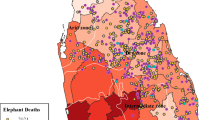Abstract
This paper provides a medical–environmental and biogeographical assessment of potential natural hazards in the Ile-Balkhash State Nature Reserve (Republic of Kazakhstan) with consideration of the tourism activities planned there. The exposure factors were analyzed for allergenic and poisonous plants and natural disease foci. The medical–geographical risks are caused by the existence of five natural foci of nosological entities in the reserve, among which tularemia and brucellosis have high morbidity levels in the region. The mammals inhabiting the reserve act as carries of natural-focal diseases, and a large number of poisonous and allergenically active plants grow there. This indicates that the presence of the corresponding risks require regular medical and environmental monitoring. The presented methodological scheme used to assess natural hazards may also be applied to other arid areas and regions.





Similar content being viewed by others
Notes
Latin names of animal species are provided in accordance with the book by I.Ya. Pavlinov et al. (2002).
Latin names of plant species are provided in accordance with book Botanical Geography of Kazakhstan and Central Asia (within the Desert Region) (2003).
REFERENCES
Afanas’ev, A.V., Zoogeografiya Kazakhstana (na ocnove rasprostraneniya mlekopitayushchikh) (Zoogeography of Kazakhstan Based on Distribution of Mammals), Alma-Ata: Akad. Nauk Kazakh. SSR, 1960.
Atlas of Bacterial and Virus Zoonotic Infections Distribution in Kazakhstan, Almaty: Kazakh Sci. Center Quar. Zoonotic Dis., 2010.
Bol’shoi atlas Kazakhstana (Great Atlas of Kazakhstan), Moscow: Dizain, Inf., Kartogr., 2011.
Botanicheskaya geografiya Kazakhstana i Srednei Azii (v predelakh pustynnoi oblasti) (Botanical Geography of Kazakhstan and Central Asia within the Desert Area), St. Petersburg, 2003.
Chuchalin, A.G., Bronkhial’naya astma (Bronchial Asthma), Moscow: Meditsina, 1985.
Concept of sustainable development of Ili-Balkhashskii basin, 2000. http://www.cawater-info.net/bk/water_law/ pdf/concept-ili-balkhash.pdf. Accessed February 14, 2019.
Dikareva, T.V. and Koroleva, E.G., Background medical–geographical assessment of regions with high environmental tourism potential in the Republic of Kazakhstan, Arid Ecosyst., 2017, vol. 7, no. 3, pp. 155–160.
Dikareva, T.V. and Rumyantsev, V.Yu., Cartography analysis of distribution of the allergen plants in Russia, Vestn. Mosk. Univ., Ser. 5: Geogr., 2015, no. 6, pp. 34–40.
Geologicheskaya karta Kazakhstana, Masshtab 1 : 1 000 000 (Geological Map of Kazakhstan, Scale 1 : 1 000 000), Segedin, R.A., Kim, Yu.M., Antonyuk. R.M., Grankin, M.S., Rotarash, I.A., and Krasnoborodkin, I.K., Eds., 1998. http://neotec.ginras.ru/neomaps/M010_ Kazakhstan_1998_Geology_Geologicheskaya-karta-kazahstana.html. Accessed February 14, 2019.
Izbanova, U.A., Kunitsa, T.N., Meka-Mechenko, T.V., and Lukhnova, L.Yu., Prospective use of a geographical information system for monitoring of the natural foci of tularemia in Kazakhstan, Meditsina, 2015, no. 6, pp. 12–16.
Koroleva, E.G., Bio-geoanaliz v ekologii cheloveka (Biogeoanalysis in Human Ecology), Saarbrucken: Lambert Academic, 2016.
Krasnaya kniga Kazakhstana (The Red Data Book of Kazakhstan), Alma-Ata: Kazakstannyn Kyzyl Kitabi, 2006.
Krylov, P.S., Nurgaliev, D.K., and Yasonov, P.G., Development of the Balkhash Lake (Kazakhstan) according to seismoacoustic data, Uch. Zap. Kazan. Univ., Ser. Estestv. Nauki, 2014, no. 1, pp. 128–136.
Lukhanov, L.Yu., Pazylov, E.K., Izbanova, U.A., and Sarmantaeva, A.B., Improvement of identification methods of anthrax pathogen strains and their differentiation from atypical and close-related microorganisms, Meditsina, 2014, no. 3, pp. 27–30.
Malkhazova, S.M. and Koroleva, E.G., Okruzhayushchaya sreda i zdorov’e cheloveka. Uchebnoe posobie (Environment and Human Health: Manual), Moscow: Mosk. Gos. Univ., 2011.
Map of general seismic zonation of Kazakhstan, scale 1 : 5 000 000, in Natsional’nyi atlas Respubliki Kazakhstan. Tom 1. Prirodnye usloviya i resursy (National Atlas of Kazakhstan Republic, Vol. 1: Natural Conditions and Resources), Almaty, 2010.
Ministry of Health of the Republic of Kazakhstan, 2019. http://www.mz.gov.kz. Accessed March 12, 2019.
Natsional’nyi atlas Respubliki Kazakhstan (National Atlas of the Republic of Kazakhstan), in 3 vols., Almaty: Inst. Geogr., 2006.
Pavlinov, I.Ya., Kruskop, S.V., Varshavskii, A.A., and Borisenko, A.V., Nazemnye zveri Rossii. Spravochnik-opredelitel’ (Terrestrial Animals of Russia: Handbook and Guide for Species Identification), Moscow: KMK, 2002.
Decree of the Government of the Republic of Kazakhstan no. 381 of June 27, 2018. https://online.zakon.kz/ document/?doc_id=37921962. Accessed December 28, 2018.
Statistics Committee, Ministry of National Economy of the Republic of Kazakhstan, 2019. http://www.stat.gov.kz. Accessed March 12, 2019.
Sultanova, B.M., Rachkovskaya, E.I., Ivashchenko, A.A., Berezovikov, N.N., Evstifeev, Yu.G., Gryunberg, V.V., Malakhov, D.V., Kerteshev, T.S., and Belgubaeva, A.E., The biological diversity of the planned Ile-Balkhash natural reserve, Vestn. Kazakh. Nats. Univ., 2012. vol. 33, no. 1. http://bulletin-ecology.kaznu.kz/index.php/1-eco/ article/view/391. Accessed February 21, 2019.
Voronov, A.G., Meditsinskaya geografiya. Obshchie voprosy (Medical Geography: General Problems), Moscow: Mosk. Gos. Univ., 1981, no. 1.
Voronov, G.A., Oborin, M.S., Malkhazova, S.M., and Gavrilova, I.N., Ekologiya cheloveka s osnovami meditsinskoi geografii (Human Ecology with Principles of Medical Geography), Perm: Perm. Gos. Nats. Issled. Univ., 2015.
Author information
Authors and Affiliations
Corresponding authors
Ethics declarations
Conflict of interest. The authors declare that they have no conflicts of interest.
Statement of animal welfare. All applicable international, national, and/or institutional guidelines for the care and use of animals were followed. The article does not concern any studies using animals as objects.
Additional information
Translated by L. Emeliyanov
Rights and permissions
About this article
Cite this article
Koroleva, E.G., Dikareva, T.V. & Dikarev, V.A. Assessment of Natural Hazards in the Ile-Balkhash Nature Reserve (Kazakhstan). Arid Ecosyst 9, 264–272 (2019). https://doi.org/10.1134/S2079096119040048
Received:
Revised:
Accepted:
Published:
Issue Date:
DOI: https://doi.org/10.1134/S2079096119040048




